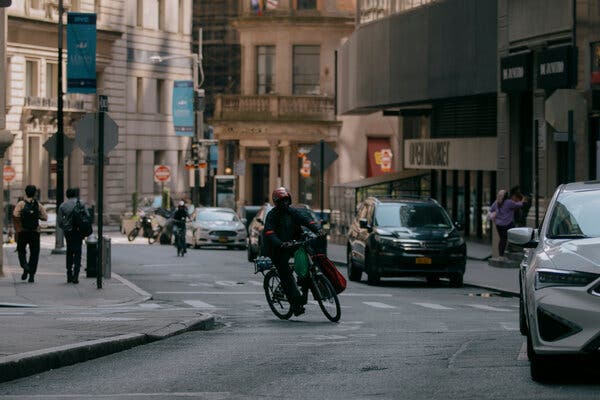e-beach
10 MW
What to Know About E-Bikes in New York City
Next month, a new city law will ban the sale of e-bikes and e-scooters that have not been certified for safety.
Many commuters and delivery workers rely on e-bikes as a greener and more economical alternative to cars.Credit...José A. Alvarado Jr. for The New York Times

By Winnie Hu
Aug. 17, 2023, 8:28 a.m. ET
Electric bikes and scooters are an increasingly popular and convenient way to move around New York City, but the lithium-ion batteries that power these micro-mobility devices have become a leading cause of deadly fires.
Now, New York will become the first city in the United States to regulate the safety of e-bikes and e-scooters, but confusion around the new law has led some to ask if the city is banning them.
Here’s what to know about e-bikes in New York City.
What classifies as an e-bike in New York?
The city currently allows three classes of e-bikes, all of which must have operable pedals and top out at 25 miles per hour.E-bikes that have been modified to go faster are not legal.
E-scooters, which can be stand-on or have a seat, are legal if they weigh less than 100 pounds and only go up to 15 m.p.h. Electric mopeds — like those rented through Revel — are also legal, but they must be registered with the state and require a driver’s license to operate.
Most e-bikes and e-scooters only became legal on New York streets in 2020, though in reality they were already in use. There is no official tally of their numbers since, unlike cars, these devices are not registered.
Some other kinds of e-mobility devices remain illegal on city streets, including electric hoverboards, skateboards, unicycles, hoverboards and Segways.
E-bikes and e-scooters are allowed in bike lanes and on streets where the speed limit is no greater than 30 m.p.h. Mopeds (electric and gas) are not allowed in bike lanes.
Why are e-bike fires deadly?
Lithium battery fires have killed 14 people and injured 93 others in New York this year, including a blaze at an e-bike shop near Chinatown that caused four deaths in June. There have been 154 fires this year as of Aug. 14.Lithium batteries have burst into flames while parked near a door or window, trapping people inside their apartments.Credit...José A. Alvarado Jr. for The New York Times
The batteries, which are also used in laptops and smartphones, can overheat or malfunction — and not only when they are charging. If that happens, they can spark explosive, fast-moving fires with little or no warning, leaving just seconds to escape. Batteries have burst into flames while parked near a door or window, trapping people inside their apartments.
New York’s leaders have tried to battle the fires on multiple fronts, including targeting unsafe battery conditions at e-bike stores, running public service announcements about e-mobility hazards, and lobbying for greater state and federal oversight over e-mobility devices.
What will the new law do?
Local Law 39, which takes effect on Sept. 16, will prohibit the sale, lease or rental of e-bikes and e-scooters — along with their batteries — that fail to meet recognized industry safety standards.Inspectors for the city’s Department of Consumer and Worker Protection, which will enforce the new law, will begin issuing violations to stores and retailers on Amazon and other online sites that sell, lease or rent uncertified devices, and to manufacturers that sell directly in the city.
Inspectors will also issue violations to resellers of used e-bikes and other e-mobility devices in marketplaces like Craigslist.
Individuals using the uncertified devices will not receive violations.
Violations can result in fines of up to $1,000 for each type of uncertified device that is found.
But the new law does not cover uncertified personal devices that are already in homes. It also does not apply to devices that are bought or leased outside the city — in New Jersey or Connecticut, for instance — and then used in the city.
New York’s law is part of a growing national effort to make e-bikes and other e-mobility devices safer, and the state’s lawmakers have proposed a federal safety standard for the lithium-ion batteries used in those devices.
What are the safety standards?
New York will require e-bikes to be tested and certified to a specific safety standard, known as UL 2849, which was developed by UL Standards & Engagement, a nonprofit organization, with input from the e-bike industry.E-scooters will have to meet a similar safety standard, UL 2272. And lithium batteries that are sold separately for use in e-bikes and other e-mobility devices will be held to a third standard, UL 2271.
The e-bike standard specifically assesses the electrical system of an e-bike, including putting its lithium battery through a series of “torture tests” to see how it reacts when overcharged, dropped, punctured with a nail, and exposed to vibrations, water and extreme temperatures.
UL Solutions, a separate for-profit organization affiliated with UL Standards & Engagement that tests and certifies e-bikes, is not aware of any UL-tested and certified e-bikes that have caught fire. But a spokesman, Steven Brewster, cautioned that there were other factors that could cause e-bike batteries to fail, including using a charger that was not compatible with a UL-certified battery.
Until now, these safety standards have been voluntary. Only a small fraction of e-bike manufacturers have opted to test and certify their e-bike designs, in part because it can cost between $30,000 and $100,000, according to industry experts.
But since New York’s law was approved in March, more manufacturers have gotten their e-bikes certified through UL Solutions or another authorized laboratory.
Currently, UL Solutions maintains a list of more than 20 companies that have certified e-bikes, and more than 40 companies that have certified e-scooters and personal e-mobility devices.
Is New York banning e-bikes and e-scooters?
Mayor Eric Adams and city officials have repeatedly emphasized that they are not banning e-bikes and e-scooters from New York streets. Indeed, they say that they recognize many commuters and delivery workers rely on e-mobility devices as a greener and more economical alternative to cars.In June, Mayor Eric Adams, center, and Fire Commissioner Laura Kavanagh, visited the site of a lethal fire at an e-bike store in Manhattan.Credit...José A. Alvarado Jr. for The New York Times
“Legal electric micromobility is a critical part of a safe, equitable and sustainable transportation landscape,” Ydanis Rodriguez, the city’s transportation commissioner, said when the new law was approved in March along with other safety measures for e-bikes. “These devices can make moving around the city easier for New Yorkers and are critical tools used by thousands of delivery workers to support our economy.”
But there has been confusion around the new law because building owners and landlords have increasingly chosen to ban all e-bikes and e-scooters from their premises, regardless of whether they have been certified for safety.
How do I use my e-bike safely?
The safest place to store and charge an e-bike or e-scooter is outdoors, according to battery and fire safety experts, but that is not an option for many city dwellers. In New York, the majority of lithium battery fires have been in residential buildings.Fire Commissioner Laura Kavanagh has urged anyone with an e-bike or e-mobility device at home to essentially do their own safety inspection.
To see if your bike has been tested and certified to the accepted safety standard, look for a label with a holographic UL mark on the bike frame or permanently affixed to its electronic case. The label will show “UL” inside a circle and “Certified” along with a safety number. Type the number into an online site to verify that the mark is authentic; watch out for counterfeits.
Do not use uncertified or refurbished batteries, which the city has also banned, or mix and match batteries and chargers that were not made to go together. Check if they are hot or have any sign of physical damage.
Do not keep e-bikes and e-scooters by an exit, including doors or windows, where a fire could block people from getting out. Do not overcharge batteries or leave devices plugged in to charge unattended.
“I do think that — like most consumer devices — these can and will be regulated,” Commissioner Kavanagh said. “But it’s getting to that point you know while battling these fires now.”





